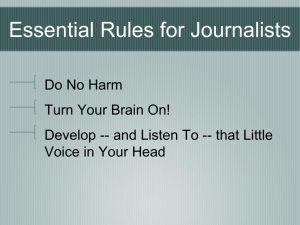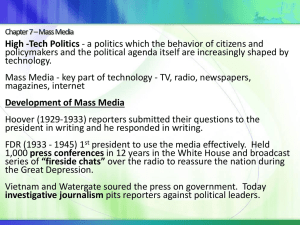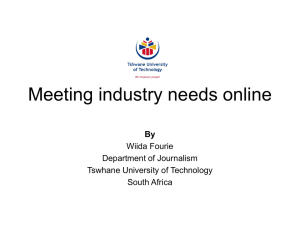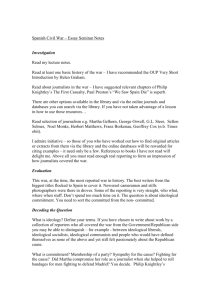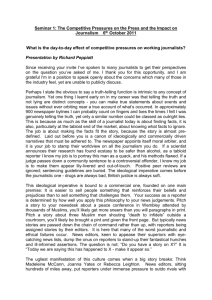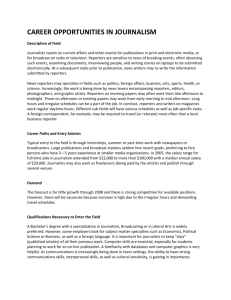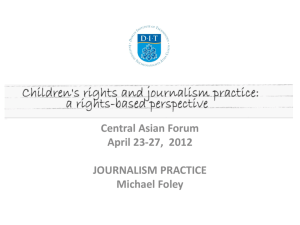Chapter 13 News Gathering & Reporting
advertisement
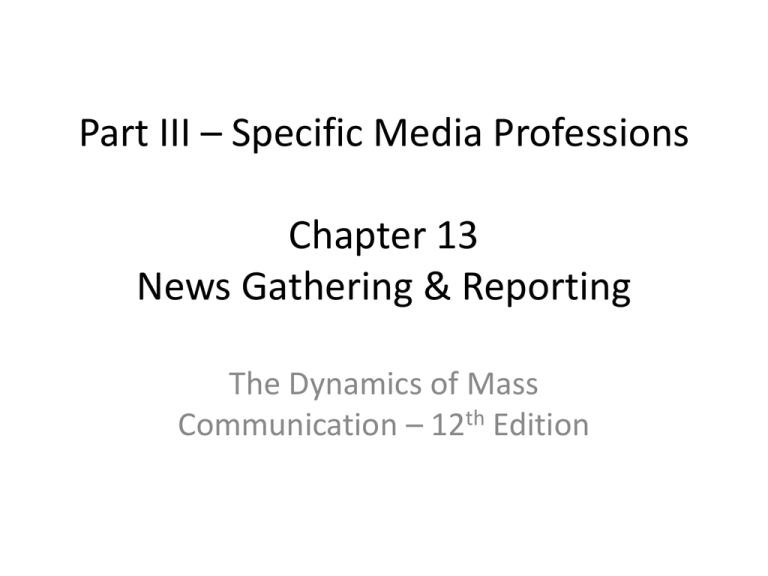
Part III – Specific Media Professions Chapter 13 News Gathering & Reporting The Dynamics of Mass Communication – 12th Edition The State of American News • Many people think news is dead, but it’s not. • The model and method of delivery have just changed in the digital age. • Americans still want news and the digital revolution has given them more control than ever over what info they consume and how and where they consume it. Deciding What Is News • News values help journalists decide what stories merit coverage and to what degree. • There are 5 core elements that characterize newsworthy events: 1. Timeliness: - News must be fresh, immediate, and current. - With Web sites operating 24/7 and bloggers providing first-hand info as it happens, the digital revolution made the “shelf life” of news shorter. Deciding What Is News 2. Proximity: - The closer a news event is to your home, the more important it is to a reader. - In addition to geographical proximity, a news story might have psychological proximity, which occurs when you identify with the story topic (health, college, jobs) regardless of the story’s geographical origin. - Social media sites give a new dimension to psychological proximity as people can find other individuals with whom they share a common connection Deciding What Is News 3. Prominence: - The more important a person is, the more valuable he or she is as a news source. - Think of all the news stories focused on well-known people from the president to sports and entertainment figures Deciding What Is News 4. Consequence (or Impact): - Events that affect a great many people are newsworthy. - The Internet has given audience members more influence in determining the consequence of certain news items - The news media can monitor the “clickstream” to monitor what articles people are reading on their websites. Deciding What is News 5. Human Interest (or Novelty): - Stories that bring out an emotion in readers have news value. - They may be uplifting, bizarre or dramatic. Deciding What Is News • In addition to the five traditional elements of news value, economics also plays an important role in determining whether a story is reported. • Some stories cost more than others to cover. • If a news station has invested in expensive technology (helicopters, studio vans, and satellite feeds), stories that utilize this technology are more likely to receive coverage. Trust and the News Media • Americans are losing confidence in the trustworthiness of their news media • In 1972, 68% said they had a “fair” amount of trust or a “great deal” of trust in the news media. In 2000, 51% reported having a “fair” amount or a “great deal” of trust. And in 2010, 43% said they a “fair” amount of a “great deal” of trust • In 1972, 30% said they had “not much” or no trust in the news media. That number rose to 49% in 2000 and to 57% in 2010 • Do you trust the news media? The News Business • Historically, advertising pays for most of the cost of gathering and distributing news • This business model worked as long as the news media drew the audiences that advertisers wanted to reach. • “Decoupling” of advertising from the news occurred when the Internet became popular and advertisers discovered that they had other, more efficient ways to reach an audience – revenue started to flow away from the traditional news media to the Web. News Reporting in the Digital Age • 6 significant ways the digital revolution has changed news reporting 1. 2. 3. 4. 5. 6. Increased # of news sources Blogs Citizen journalism Hyperlocal news Converged journalists New reporting tools News Reporting in the Digital Age • 1. More Sources of News: the Internet has increased the number of available news sources A. General news sites = CNN.com or USAToday.com B. News Aggregators = Google News etc. that offer a digest of news from other sources C. Specialized News sites that offer highly focused content = ESPN for sports news, Wall Street Journal’s Web site for financial news D. Blogs News Reporting in the Digital Age • 2. Blogs: Several characteristics of blogs are important. A. Blogs represent another source of news, free from traditional economic, corporate, political, or advertising considerations. There are blogs devoted to all sorts of topics, and blogs offer alternative points of view to traditional media. B. Blogs can have an agenda-setting effect, and can help keep events in the news cycle. C. Blogs can provide a check on traditional media and hold traditional media to higher levels of scrutiny. D. Blogs provide an additional outlet for reporters to explain why they reported a story in the way they did. E. Blogs have made it possible for everyone to become a reporter, and paved the way for citizen journalism. News Reporting in the Digital Age • 3. Citizen Journalism - In citizen journalism, ordinary citizens become amateur reporters. - This trend was facilitated by digital and cell phone video cameras and high speed Internet access. - Traditional news media encourage citizen journalism, and many media outlets ask audience members to submit photos and video clips. - Citizen journalism is popular with the mainstream news media in part because it’s free content, but it also empowers the audience. - News organizations are no longer the only ones that determine what is reported and how. News Reporting in the Digital Age • 4. Hyperlocal News – refers to news coverage for a very small community. – It can be a single zip code or interest group in a defined geographic area. – Most hyperlocal news appears on Web sites. Publishers of hyperlocal news hope that the extremely local focus and the coverage of topics ignored by the traditional media will draw in people who generally do not consume news. – Example: Patch.com – Making money from hyperlocal news is a challenge. Most web sites sell inexpensive ads to local merchants or entrepreneurs who can’t afford traditional media ads. News Reporting in the Digital Age • 5. The Converged Journalist – The converged reporter has the skills of a print, photo, and video journalist. – They can write, shoot and post photos online, and do video reports. – The term backpack journalist describes the next generation of digital reporters. These are "do it all" journalists who carry a digital camera, laptop computer, and satellite phone. They produce stories for print, television, and online media. – Reporters who work out of their cars and cover local community news are called mobile journalists, or mojos. News Reporting in the Digital Age • 6. New Reporting Tools – The Internet allows reporters easier access to documents, databases, government records, and expert sources. – However, journalists must learn the appropriate skills to take advantage of all the Internet has to offer. These skills are generally referred to as computer-assisted reporting. Categories of News and Reporting • News can be broken into 3 categories: 1. Hard news - traditional fact-oriented journalism - embodies the famous journalistic questions of who, what, where, when, why, and how - Hard news generally embraces all but the human interest values, with emphasis on the values of timeliness and consequence. - Hard news stories make up the majority of news reporting, and tend to be the lead stories in broadcast news or appear in Section 1 of a newspaper. • Categories of News and Reporting 2. Soft News or Features - Covers a wide range of topics - Usually relies heavily on the human interest news value and are entertaining. - Many TV and print vehicles are based primarily on soft content, such as Entertainment Tonight, or the “Life” section of USA Today. - Prime time newsmagazines such as 60 Minutes contain substantial amounts of soft news, as do the early morning network TV shows. - Features are more common on TV than in radio. Categories of News and Reporting • Investigative Stories – unearth significant information about matters of public importance through the use of non-routine information-gathering methods – Corruption, political scandals, business cover-ups, drug trafficking, and institutional inefficiencies are typical targets – An investigative piece requires considerable time and money, so it is usually longer than the typical news item. – This type of story may run as an extended series over a period of several days – Broadcast media might air the story as a 10-15 minute documentary segment on a newsmagazine program (Dateline) – Bloggers have also entered the realm of investigative journalism. The News Flow • Print Media – There are two main sources of print news: staff reports and wire services. – The city editor heads a paper’s reporting staff, assigning stories to reporters. – There are two types of reporters: • the beat reporter who specializes in covering a topic such as fire and police departments, government, schools, or business • the general assignment reporter, who covers whatever assignments come up. – The reporters' stories are sent to the city editor who approves them and sends them to the copy desk for further editing. – The managing editor and assistant managing editor are responsible for the overall daily preparation of the paper. The News Flow • Broadcast/Cable Media – Broadcast news sources are similar to newspaper sources. Special wire services cater to broadcast media, and local reporters are assigned to cover nearby events. Many broadcast stations also subscribe to syndicated news services and if affiliated with a network have access to network news feeds. – In terms of organization, the news director is responsible for the overall news operation – the executive producer oversees all the producers in the newsroom. Typical responsibilities of the executive producer include: • Deciding what stories are covered and who covers them • Deciding the order in which stories appear in the newscast • Determining the amount of time each story is given • Writing copy for some stories • Integrating live reports into the newscasts – The assignment editor assigns and monitors the activities of reporters and camera crews – Other broadcast positions include on-air reporters and anchors, general assignment reporters, photographers, editors, news writers and productions assistants The News Flow • Online Media – The news flow & production process is similar to that of the traditional media. – Top executives decide on the site's structure and specialty elements (sports, weather, financial, entertainment). – Editors determine the content – Staff members take care of the technical work – Some online news sites employ reporters who do original reporting for the Web site. The Associated Press • The Associated Press (AP) = a wire service that provides much of the news about what is going on outside of one’s local community. • The purpose of a wire service is to provide newspapers with correspondents and coverage that the papers couldn’t otherwise afford. – A wire service is the eyes and ears for local papers and broadcasting stations that can’t afford to have people stationed all over the country • Newspapers pay for wire service news on a sliding scale: the bigger the paper’s circulation, the more they pay. The Associated Press • The AP has about 240 bureaus around the world • In 2010, it served about 16,000 customers worldwide, including about 1,700 newspapers, 5,000 radio and TV stations, and more than 500 international broadcasters. • It has shifted its focus in recent years to supplying more content to cable TV and the Web. In fact, broadcasters and digital media have replaced newspapers as the primary source of the AP’s income. Media Differences & Similarities in News Coverage • Print or broadcast journalism: which is better? – Proponents of print journalism said that broadcast news was shallow, while print could handle in-depth and lengthy reports. – Advocates of broadcast journalism said that print media lacked the visual dimension and was oldfashioned and dull. • The debate has subsided now that both emphasize their Web versions, which look similar: they both have headlines, story summaries, links to full stories, photos and video. Media Differences & Similarities in News Coverage • Similarities Among the News Media: editors and reporters in each medium share the same basic values and journalistic principles: – honesty: stories should be as truthful as possible – accuracy: fact checking must be done for every story – balance: journalists must make sure they tell all sides of a story – objectivity: news reporting should be untainted by bias and without personal comment – credibility: the news reporting should be from believable, reliable, trusted sources. • One of the problems with online citizen journalism is that a reader can never be sure if citizen journalists subscribe to the same values as professional reporters in terms of checking facts, cross-validating sources, providing an objective stance and following codes of the profession’s ethics. Readership and Viewership • The audience for network news, local news, newspapers, and news magazines has been shrinking – and getting older – for about 30 years. • The average age of the typical TV newscast viewer is around 60. • With the exception of the Internet, there has been a noticeable decline in the consumption of news. • Some say they have no interest in following the news • Others go online to traditional or nontraditional sites. • The smaller the audience means less advertising revenue, which results in cutting personnel and closing news bureaus. The News According to Who? • Should news be what the audience wants to know or what the audience needs to know? • Who should decide what news is reported? Reporters or the readers/viewers?
